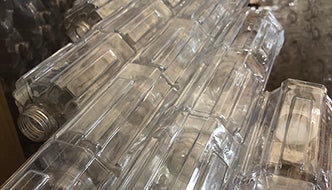Powerful hurricanes and earthquakes have wreaked havoc in the United States and around the world in recent years, often leaving people stranded for months and even years without access to water, food, and shelter. A unique collaborative project at Rensselaer Polytechnic Institute seeks to provide a sustainable solution, while also considering the environment.
After a disaster strikes, first responders and other aid organizations mobilize to send needed supplies such as water, food, and medicine. Bottled water is sent by the tons, but all too often, the empty plastic bottles end up in the trash stream.
Students and faculty in the Schools of Engineering and Architecture are conducting a multifaceted research project that includes structural and architectural design, along with strength analysis, of revolutionary transitional shelter designs built using the patented plastic interlocking bottles of Friendship Products LLC, led by inventor Timothy Carlson. The collaborative team is led by Mohammed Alnaggar, assistant professor of civil and environmental engineering, and Lydia Kallipoliti, assistant professor of architecture. They are working with Ashraf Mansour at the National Research Centre in Cairo, Egypt, and members of the Rensselaer Center for Architecture Science and Ecology in New York City, including Josh Draper. They are assisted by fabrication consultant Tom Roland from the School of Architecture and Andreas Theodoridis, Ph.D. student at CASE.
The students working on the project are: Adam Beres, Bryce Crawford, Amanda Esso, Reed Freeman, Emily Freeman, Jacob Laird, Deegan Lotz, Christopher Michelangelo, Arun Padykula, Raina Page, Abigail Ray, Daniel Ruan, Emily Sulanowski, and Stefanie Warner.
The goal is to re-use the empty bottles to construct and structurally test different structural components (walls, columns, and roofs) and then design and build a prototype for emergency shelters for displaced populations under conditions of distress. The structure will be approximately 15 square meters in size and will be erected on campus in early May.
According to Kallipoliti, the design studio, Second Lives | After Bottles, functions as a design-build think tank, bringing together architecture and engineering students and professors in a cross-disciplinary platform to work collaboratively and create innovative strategies for material recycling.
The aim is to foster dialogue on topics relating to recycling of industrial products as building materials and on sustainable building construction. “During the design studio, we are investigating several prototypes presenting variable solutions of construction and deconstruction of small inhabitable spaces using the bottles manufactured by Friendship LLC,” said Kallipoliti.
The idea is to use the bottles as sturdy, low-cost, easily assembled building blocks. Each modular unit slide-locks with other units to form strong wall and building structures that can be filled with dirt, sand, or other materials to form a sturdy structure without the use of mortar. The Friendship bottles are able to interlock without joints due to their embedded creases.
“This project presents a unique collaboration to optimize function and shape,” said Alnaggar. “The structural engineering research focusing on studying all the mechanics of the interlocking between the bottles and its scaling up to the full structural scale provides the architectural engineers with the needed properties to create not only an aesthetically appealing structure, but also a structurally sound and safe one.”
According to Alnaggar, the trend in dealing with these plastics is to shred them and then either recycle the material or put it in landfills. Without any additional energy costs to transform the bottles for further use, his research provides additional lives to these bottles as permanent parts in buildings. His students are investigating strength and thermal insulation properties of the bottles for their incorporation into concrete sandwich walls and hollow block slabs to save on materials and energy consumption. “We are taking the bottles from our landfills and putting them sustainably into our structures to reduce weight and provide insulation for a better energy consumption,” he said.
After being displayed at Rensselaer, the pavilion will be brought to Industry City in Brooklyn for the WantedDesign event May 17-21. WantedDesign aims to provide a platform dedicated to promoting design and fostering the international creative community at large throughout the year. The Rensselaer Center for Architecture Science and Ecology is conducting a complementary investigation to the Second Lives | After Bottles team, focusing on the environmental performance of a transitional shelter. The project’s research goals include environmental sensing and data frameworks for comfort and well-being in transitional shelters; the role of Friendship bottles in waste reduction and reuse within disaster relief logistics; and the use of Friendship bottles as a performative building system. CASE’s transitional bottle shelter test bed will be installed alongside the Second Lives | After Bottles pavilion at WantedDesign Brooklyn 2018.


